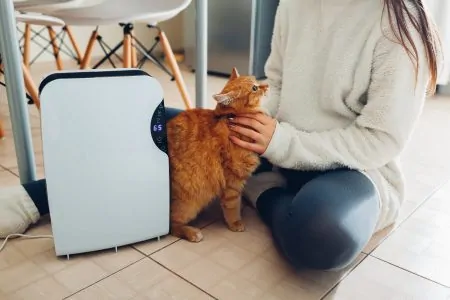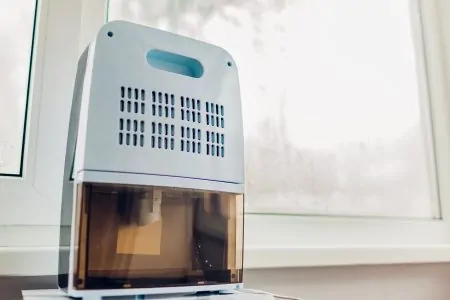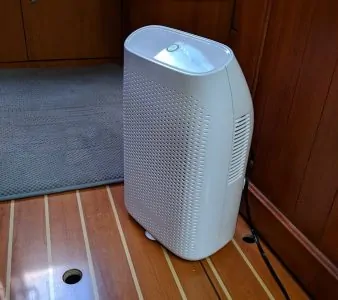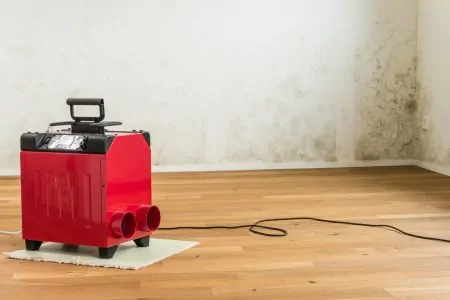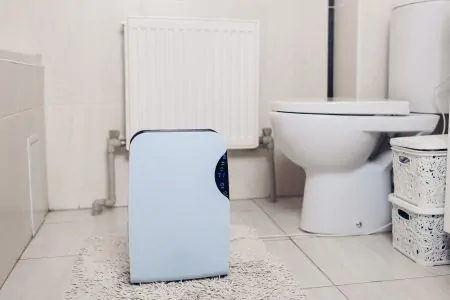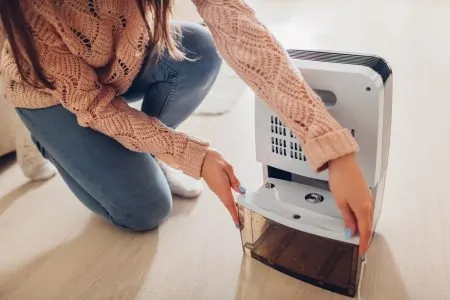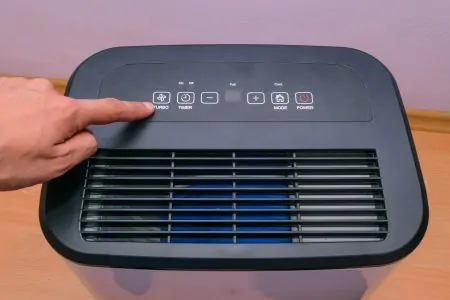Buying a new dehumidifier can be overwhelming. It’s easy to feel bombarded with advice and people telling you what to choose. A common question is: “What size dehumidifier do I need?”
By knowing what size and capacity are suitable for you, you’ll get the best bang for your buck.
If you purchase the wrong size, you could end up with a cumbersome energy waster that’s way too loud to use in the living room. On the other hand, if you choose one that’s too small, it might not be able to handle dehumidifying your home.
We’ll help you determine what size you need using our handy sizing chart.
Key Takeaways
- Dehumidifier sizing refers to capacity, or how much moisture it can remove in 24 hours (pints per day, PPD).
- Choose the right size based on the area’s square footage and humidity level using a sizing chart.
- Whole-house dehumidifiers are suitable for large spaces, while mini dehumidifiers work well in small rooms.
- Consider other factors like climate, proximity to appliances, and pets when choosing the right dehumidifier capacity.
How Are Dehumidifiers Sized?
Dehumidifier sizing generally refers to capacity or how much moisture the unit can remove in 24 hours. This is also known as pints per day (PPD). You can find different models ranging in capacity, with the most common being 30, 50, and 70 pints.
However, there are also smaller models at 20 pints or even substantial units that can remove more than 100 pints. Furthermore, a dehumidifier’s capacity will give you a rough idea of how much space it can cover. By knowing the dehumidifier’s square footage and your area, you can quickly find a suitable unit.
Sizing Chart
To help you get a quick idea of sizing your dehumidifier, we’ve created an easy-to-understand chart:
| Conditions | 300 – 500 Sq.Ft. | 700 – 1,000 Sq.Ft. | 1,500 – 2,500 Sq.Ft. |
| Moderately Damp | 10-pint | 20- or 40-pint | 50-pint |
| Very Damp | 20- or 30-pint | 30- or 50-pint | 50- or 60-pint |
| Wet | 40- or 50-pint | 50- or 60-pint | 70-pint |
| Extremely Wet | 50-pint | 60-pint | 70- or 100-pint |
How to Choose the Right Type of Dehumidifier
Now that you have a rough idea of what capacity dehumidifier you need, it’s time to measure your room or home. You might already know the exact square footage of your home — then you’re nearly all set. For those who are unsure, here’s how to measure a room:
- Measure the length of the room in feet.
- Measure the width of the room in feet.
- Multiply the two measurements to find the square footage.
Some homeowners buy one for a specific area, such as the basement. However, you might need the dehumidifier somewhere else. If you plan on moving the dehumidifier between rooms, measure the largest area to ensure it will be big enough.
To help give you a better idea of what type of dehumidifier might suit you, here are a few examples.
Large Spaces More Than 2,500 Square Feet
If you often deal with humidity, mold, and musty odors, you need a whole-house dehumidifier. Whole-house dehumidifiers are ducted to your HVAC system. They work by dehumidifying the air before it enters your home.
Whole-house dehumidifiers cover large areas of up to 3,000 square feet or more. The initial price is generally higher than portable units, but they’re cheaper in the long run. In addition, installing a whole-house dehumidifier will help your AC to work more efficiently since it’s easier to cool dry air.
Small Spaces Between 100 and 250 Square Feet
In smaller rooms, we recommend a mini dehumidifier.
Mini dehumidifiers can generally cover between 100 and 300 square feet, depending on the model. They work very quietly yet effectively when in a properly sized room.
Mini dehumidifiers are compact and easy to fit in tight rooms. Most mini dehumidifiers also have an auto-shutoff function that turns the unit off when the tank is full. Unfortunately, they generally have a small reservoir that can only hold a few pints.
Homeowners prefer mini dehumidifiers in the bedroom because they’re very quiet. Due to the small size, they can’t fit a noisy compressor, so instead, they use thermoelectricity.
Cool Environments
If you live in a cold environment, you’re probably often advised against buying a dehumidifier. This is because regular refrigerant dehumidifiers won’t work in cold temperatures due to the coils freezing over.
Take Note
However, there’s a solution to your humidity problem: desiccant dehumidifiers. A desiccant dehumidifier is fitted with a rotor filled with sheets impregnated with desiccant material. As the air is drawn in through a fan, it passes the rotor, where moisture is adsorbed.
Furthermore, desiccant dehumidifiers are much quieter because they don’t have a compressor. They’re also more energy-efficient and effective at drying already dry air (2).
Hot Environments
If you live someplace hot, where it seems like the humidity just won’t go lower than 70 percent, you need a strong dehumidifier. For this type of environment, nothing will beat a refrigerant model. These are highly effective at removing large amounts of moisture and can work in higher temperatures where desiccant models struggle.
Refrigerant dehumidifiers draw air in through a fan and then cool the air on a set of coils. The refrigerant liquid is pumped through the system, converting between gas and liquid form as it cools and heats.
How to Choose the Capacity of the Dehumidifier
Knowing the area coverage required for your dehumidifier is only one part of making the decision. Another important thing to consider is how humid your home or specific room is. To help you figure this out, here are a few signs to look for:
- Moderately damp: Clammy or musty-feeling rooms mean your house or space is moderately damp. This generally isn’t a year-round occurrence but occurs more when the weather becomes humid.
- Very damp: If you often notice a distinct musty odor and your home feels damp, it’s categorized as very damp. In this case, you might notice damp spots on walls or floors.
- Wet: You might begin to notice that your house is “sweating”. This may look like water beads on the walls or floors. Rooms may also feel very damp or smell damp at all times.
- Extremely wet: This is the more extreme case where you’ll notice standing water on the floor. This might be caused by a leak or other water damage case, and you must fix the source.
Many homeowners use a humidity meter to measure the exact humidity levels. Although this is effective, it’s not always necessary. By comparing your space to the points above, you can quickly get an idea of the humidity situation in your home.
To help you a little more, follow the guide below to see what dehumidifier would suit your space.
1. Moderately Damp Spaces
For moderately damp spaces, you won’t need a bulky dehumidifier. Instead, we recommend you try out a 30-pint dehumidifier for large spaces of around 2,500 square feet. This will be highly effective in any space between 1,000 and 2,500 square feet without being too noisy or large.
In smaller areas between 500 square feet and 1,000, we recommend a 10- or 20-pint dehumidifier. These are smaller and can easily fit in compromised spaces. As a bonus, if you want to save some energy, try a desiccant unit for a more peaceful environment.
2. Very Damp Spaces
In very damp spaces, you’ll need a dehumidifier that can pull in more moisture, which means choosing a larger capacity.
For large areas between 1,000 and 2,500 square feet, we recommend a 50-pint unit. This will be able to pull a significant amount of moisture quickly without getting overwhelmed and using more energy.
For smaller areas between 500 and 1,000 square feet, we suggest you choose a 30-pint unit. Fortunately, 30-pint units are still compact enough that they can fit in compromised spaces.
3. Wet Spaces
You need a strong dehumidifier if you notice water beads on the walls or floors. Therefore, we recommend a 50- or 70-pint dehumidifier for areas between 1,000 and 2,500 square feet. These sizes will be noisier, but they’ll be able to remove moisture quicker and more efficiently.
In smaller spaces between 500 and 1,000 square feet, we recommend choosing a 30- or 50-pint unit. A 50-pint might be bulkier, but getting the moisture out is important to avoid mold or mildew.
4. Extremely Wet Spaces
If you’re noticing standing water in different areas of your home, it’s time to call in the big guns. It’s crucial that you get the moisture out and dry the space quickly to avoid water damage and mold.
Keep In Mind
Your home might be recovering from a flood or a significant leak in the pipes. In this case, a low-grain refrigeration (LGR) dehumidifier is beneficial. It uses double cooling that helps keep air temperatures lower, which makes it easier to dry (4).
If you feel like LGR units are too much, you can also choose a 70-pint dehumidifier for large spaces. In smaller spaces, we recommend a 50-pint.
Other Factors to Consider
Many things can contribute to higher humidity indoors, so these also need to be considered. Here are a few examples:
- Humid climate: If you live in an already humid climate, the relative humidity indoors will be higher. We recommend adding 10 pints to your dehumidifier. In other words, if you would normally choose a 50-pint, go for 60-pints instead to compensate for the high humidity.
- Nearby washer or dryer: If you’re living in a smaller apartment or townhouse, the washer or dryer is likely close to your living space. This can cause the humidity to rise slightly — add five pints.
- Will the dehumidifier be in the kitchen: As we’re cooking our favorite meals, the humidity can rise. Therefore, if you need a dehumidifier in the kitchen, consider adding five pints to ensure it can handle the condensation.
- AC: Air-conditioning units work nearly the same as dehumidifiers, so they can benefit from each other. If you often work the AC during the summer, you can choose a slightly smaller dehumidifier to save energy. The two appliances will work together to create a dry and cool environment.
- Pets: If you have pets, especially a big furry dog-pal, keeping the humidity low is crucial. Thanks to the extra fur, pets have a harder time cooling down during the summer, and they risk heat strokes (5). Because of this, we recommend a large dehumidifier or whole-house dehumidifier. This will create a comfortable space for your furry friends.
FAQs
Getting It Right
Dehumidifiers are available in various sizes, making it tricky to find the right one for you. The size of the dehumidifier refers to its capacity in pints, which shows how many pints of moisture it can remove. Common sizes include 30-, 50- and 70-pint. However, it’s also possible to find 20-, 40-, 45- and 100-pint units.
Before settling on a size, you must consider how large the space is and the conditions within it. You can quickly figure out the square footage by multiplying the length and width of the room. In addition, you must consider how humid your home or space is and then choose accordingly.
